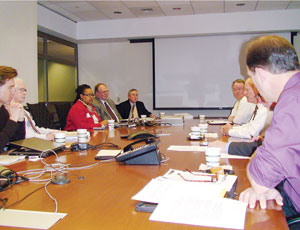Earning a Leadership in Energy and Environmental Design certification is a good start, but airport project designers and builders need to move beyond it, say industry officials.
Simply relying on �checklists� of environmental items is �the tail wagging the dog,� said David Callan, director of sustainable design and high performance building technology for Syska Hennessy Group Inc., Chicago, at a roundtable held in New York City last month by McGraw Hill publications ENR and Aviation Week. The �tail wagging the dog� metaphor became a popular phrase for the four airport officials, three engineers, architect and contractor participating in the roundtable.�

“LEED doesn’t address life-cycle costs,” said Mike Chalmers, AECOM vice president. “It’s a starting point, and a good one, but we need to build on it.” That requires innovative thinking for an airport project team, noted Vlasta Poch, Washington, D.C.-based design principal architect for HNTB Architecture Inc. “The building itself becomes a much easier exercise with the LEED checklist,” he said. “But it’s still up to you as designer to see what are the right and best sustainable features for this particular site. There’s no boilerplate [solution].”
Other challenges lie outside the team’s control, including perceptions of return on investments. Philadelphia Airport Director Charles Isdell recounted how the airport last year committed $1 million over five years to wind energy development. The 13,000 MW/hours will be equal to planting 970,000 trees or not driving more than 12 million miles. But when asked how much money the investment would save, Isdell cited the cost—and “interest seemed to dissipate.”
William DeCota, aviation director for the Port Authority of New York & New Jersey, says the port authority’s goal is to be carbon-neutral by 2010. “But we still have to understand the full range of what’s possible,” he said. “What is sustainable beyond LEED?” Reducing paperwork involved in air travel through e-technology and reducing congestion and idling time of planes will be key, DeCota added.
The attendees concurred it may make more sense to follow voluntary efforts at creating green guidelines for airport construction, as depicted in manuals from Los Angeles and Chicago. “Let these manuals be the baseline,” said Callan. That baseline could be built upon with carbon footprint studies. Poch notes that HNTB did one for Santa Barbara’s airport. It led to a list of suggestions — such as constructing a new cross-field taxiway to reduce taxiing time, he noted.
Airports shouldn’t hold their breaths for federal guidance on such efforts. “We have yet to see at the federal level... energy master plan requirements or carbon footprint plans,” said William Fife, aviation consultant.



Post a comment to this article
Report Abusive Comment